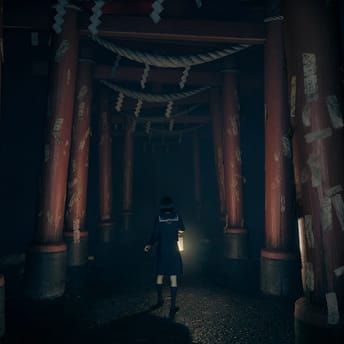
Silent Hill f System Requirements for PC Guide
Silent Hill f is a new successful entry in Konami’s survival horror series, developed by NeoBards Entertainment on Unreal Engine 5 for Windows PC, PlayStation 5, and Xbox Series X|S. The global release rolled out on September 25, 2025.
This article breaks down the official Silent Hill PC system requirements posted on Steam, explains what ‘minimum’ and ‘recommended’ mean in terms of FPS and quality presets, and discusses logical higher-end targets, mapping them to today’s common gaming CPUs and GPUs.
You’ll find practical expectations for 1080p, 1440p, and 4K resolutions, guidance on VRAM headroom, storage, and SSD considerations, as well as recommendations on what to tweak first if you need extra performance. We also cover feature support, primarily including upscalers such as DLSS, FSR, or TSR, and compare the PC experience with that of the PS5, Xbox Series, and Steam Deck consoles.
Silent Hill f PC requirements
Minimum
Recommended
Performance Target
720p at 30 FPS
1080p at 60 FPS
Processor
- Intel Core i5-8400
- AMD Ryzen 5 2600
- Intel Core i7-9700
- AMD Ryzen 5 5500
Graphics Card
- Nvidia GeForce GTX 1070 Ti
- AMD Radeon RX 5700
- Nvidia GeForce RTX 2080
- AMD Radeon RX 6800 XT
System Memory (RAM)
16 GB
16 GB
Storage
50 GB, SSD recommended
50 GB, SSD required
OS
64-bit Windows 11 only
Minimum PC Requirements for Silent Hill f
Silent Hill f requires a 64-bit PC running Windows 11. The minimum system requirements include an Intel Core i5-8400 or AMD Ryzen 5 2600 processor, 16 GB of RAM, and a DirectX 12-compatible GPU, such as the GeForce GTX 1070 Ti or Radeon RX 5700. You’ll need 50 GB of free storage (an SSD is recommended).
Although Intel GPUs are not listed in the recommended specs, Silent Hill f is supported in Intel’s latest Arc Game On drivers, so no major launch or compatibility issues are expected.
At these minimums, the game targets the Performance preset at 720p/30 FPS. Expect to use low settings, limited texture quality due to VRAM constraints, and minimal headroom for background tasks. If you’re on older HDD storage, loading times will be noticeably longer.
Windows 11–only support will likely disappoint some players, but it’s a logical choice for modern DX12 features, scheduling, and I/O, and it aligns with the latest Steam Hardware Survey trends, where Windows 11 now dominates among active gaming PCs.
The GTX 1070 Ti baseline is especially encouraging for an Unreal Engine 5 title, signaling broad accessibility and that late-Pascal and first-gen Navi cards remain viable at low settings. In short, the bar to entry is low relative to the game’s production values, and most mid-range rigs from the past few years should meet the requirements.
Recommended PC Requirements for Silent Hill f
Target setup: a 64-bit Windows 11 PC with an Intel Core i7-9700 or AMD Ryzen 5 5500 processor, 16 GB of RAM, and a DirectX 12-compatible GPU, such as the GeForce RTX 2080 or Radeon RX 6800 XT. You’ll need 50 GB on an SSD (now required).
At these specs, expect the Performance preset to deliver 1080p/60 FPS, while the Quality preset targets 1080p/30 FPS. Higher resolutions become achievable through upscaling; more VRAM (12–16 GB) will provide extra headroom for high-textured content.
As of August 2025, DX12-class GPUs comprise approximately 92% of active PCs, ensuring the game’s baseline aligns with where players already are. CPU headroom is mainstream: six-core chips are the largest group, according to the Steam hardware survey, so the processor shouldn’t bottleneck most players. Overall, the GPU ask is moderate to high but common across today’s Steam landscape.
High PC Requirements for Silent Hill f
For 1440p at Ultra, expect a near-60 FPS experience with a GeForce RTX 4070 or a Radeon RX 7800 XT when you enable DLSS, FSR, or TSR in Quality mode. A 4070 Ti will provide sufficient headroom for better settings of higher FPS for modern displays. Pair this with a modern 6-core CPU and 32 GB of RAM (it reduces asset streaming stutters, which is a known problem in UE5 titles).
For 4K Ultra, aim for a GeForce RTX 4070 Ti or RTX 5070, or a Radeon RX 7900 XT. Plan on using upscaling in Balanced or Performance mode to maintain frame rates in the 60 FPS range. You may need to adjust various settings, including fog, reflections, and global illumination settings, to achieve a stable FPS, as these are significant expenses in UE5.
VRAM is the hard limiter at Ultra textures. 12 GB is a safe baseline, and 16 GB is comfortable, especially at 4K, where Ultra textures can consume 12 to 14 GB of memory. If you are on an 8 GB card, start by dropping textures to High, then trim shadow quality, virtual shadow maps, volumetrics, and Lumen quality before adjusting geometry settings.
Supported Technologies in Silent Hill f
Ray tracing, DLSS, FSR, and TSR support
At launch, Silent Hill f features Nvidia DLSS Super Resolution and DLAA. That’s the only RTX feature that Nvidia and Konami have explicitly confirmed for the day-one release.
In-game upscaling also supports AMD FSR (super-resolution). However, there’s no Intel XeSS option in the menu, and no built-in frame generation is available. Expect DLSS/FSR and built-in UE5 TSR to be the primary tools for stabilizing 60 FPS at 1080p/1440p and for making 4K possible.
On ray tracing: the game relies on UE5 Lumen. In other words, what you get by default is the software Lumen path for GI/reflections, with higher image-quality presets pushing GPU/VRAM usage.
Trade-offs and practical guide
DLSS/FSR Quality is the cleanest option for 1440p Ultra; Balanced/Performance becomes useful at 4K when you want to hold 60 FPS.
Enabling actual hardware Lumen/RT via mods can deepen indirect lighting, reflections, and shadow detail, which suits a horror aesthetic. But expect a sharp performance hit and potential bugs. Frame generation isn’t included in-game.
If you have an RDNA 4 GPU, AMD’s current driver can automatically elevate some FSR 3.1 titles to FSR 4 via a driver-side override; this is a platform feature, not a Silent Hill f–specific integration.
Storage and SSD requirements
Silent Hill f needs 50 GB of free space. On minimum specs, an SSD is recommended, while the recommended spec requires an SSD. Expect much longer load times and a higher risk of mid-gameplay freezes on HDDs. Storage needs can rise over time with patches and DLC. Silent Hill f does not implement Microsoft DirectStorage.
Compared with recent horror releases, Silent Hill f’s footprint is moderate. Alan Wake 2 requires an SSD with at least 90 GB of free space. Resident Evil 4 Remake requires 68 GB of storage space on PC and benefits from an SSD, even though it isn’t listed as strictly required. Amnesia: The Bunker is lighter, weighing 35 GB, and will run from an HDD; however, an SSD still improves loading times.
Silent Hill f Console Comparison
Both current-gen consoles (PS5, Xbox Series X|S) utilize custom AMD SoCs featuring Zen 2 CPUs, 16 GB of GDDR6, and RDNA 2 GPUs. In practice, they target similar visual presets with dynamic resolution and reconstruction to hold 60 FPS in Performance modes, while Quality modes typically aim for 30 FPS with higher settings.
For Silent Hill f, specifically, if you want a PC experience comparable to console Performance modes, plan for 1080p/60 High–Very High on GPUs around the RTX 3060 Ti/RX 6700 XT and 1440p/60 Ultra (with upscaling) on RTX 4070-class hardware.
Finally, consoles mandate fast NVMe SSDs and ship with tightly tuned I/O paths; PC users on HDDs will experience longer load times and more streaming hitches. Running Silent Hill f from an SSD is strongly recommended.
Steam Deck and handhelds
The game is playable on Steam Deck. Some on-screen text is small and difficult to read, and achieving optimal Steam Deck performance requires manual graphics tuning. Expect low settings at 1280×800 with a 30 FPS cap to be the safe target. UE5’s Lumen and heavy post-processing make native 800p at higher presets unrealistic on the Deck’s iGPU.
Use the Performance preset, set render scale 75%, enable TSR (Quality/Balanced), and keep textures on Low/Medium to avoid VRAM spikes. On Deck OLED, a 40 Hz refresh rate with a 40 FPS cap can work in lighter scenes, but you’ll likely drop to 30 in some areas.
For ROG Ally and Lenovo Legion Go, with higher power budgets, these handhelds can support resolutions of up to 900p-1080p at low to medium settings. At 25-30 W (plugged in), aim for Balanced upscaling and a 40-60 FPS range; at 15–20 W (battery), plan for 900p or 800p with Quality upscaling and a 30-40 FPS cap. Prioritize Lumen quality at Low, tune down shadows/volumetrics.
VRAM and shared memory constraints. Handheld APUs share system RAM with the GPU. In most scenes, 8 GB effective VRAM is borderline, so High/Ultra textures can cause stutters. Stick to Low/Medium textures and limit streaming pool sizes.
Silent Hill f Optimization Tips for PC Players
Install Silent Hill f on an SSD and keep 10-15 GB free for patches and shader caches. Update your GPU drivers and reboot before launching for the first time. 16 GB of RAM is the minimum; if you frequently multitask or alt-tab, 32 GB reduces streaming hitches.
The heaviest settings in UE5 games include lighting and global illumination, shadows with virtual shadow maps, volumetrics and fog, as well as high-resolution reflections. Ambient occlusion is a lightweight setting and can be cranked up.
Lower Lumen or overall lighting quality by one step first, then drop shadow quality or resolution, then reduce volumetrics or fog distance. Reflections come next; prefer a lower reflection resolution or fewer bounces. Post-processing features like motion blur, depth of field, and film grain are optional but can be disabled for a slight FPS boost and a cleaner image.
Keep anisotropic filtering high since it is inexpensive and improves ground and texture clarity. Set the texture quality to match your VRAM budget; eight gigabytes is borderline at Ultra, while twelve to sixteen gigabytes is safer for high presets and 4 K resolution. Use the upscaler. If the image appears soft, adjust the in-game sharpness slightly rather than turning off the upscaler.
Match the fix to the bottleneck:
- If you are GPU-limited, rely on the upscaler and reduce Lumen, shadows, and volumetrics.
- If you are CPU-limited, cap the frame rate to 60, reduce LODs, effect density, foliage, or streaming distances to optimize performance.
- If you are VRAM-limited, lower the textures by one tier, keep the resolution, and avoid high-resolution reflection probes, leaving one to two gigabytes of VRAM headroom.
FAQ
Can Silent Hill f run on 8 GB RAM?
No. The official RAM minimum is 16 GB. With only 8 GB, you’ll experience severe stuttering, rendering the game unplayable.
Does Silent Hill f require an SSD?
According to the recommended specification, an SSD is required; for the minimum, it’s strongly recommended. HDDs dramatically increase load times and can cause freezes.
What GPU do I need for 4K Ultra in Silent Hill f?
Plan on using an RTX 4070 Ti or Radeon RX 7900 XT with upscaling (DLSS/FSR/TSR Balanced or Performance) for a 60 FPS experience. Native 4K/60 typically requires an RTX 5080 or RX 7900 XTX-level GPU; even then, Quality upscaling stabilizes the 1% lows.
Is Silent Hill f optimized for Steam Deck?
It’s playable, but some on-screen text is small and hard to read, while getting good Steam Deck performance requires manual graphics tuning. Expect low settings at 1280×800 with a 30 FPS cap. Use the in-game upscaler and keep textures set to Low/Medium.
Does Silent Hill f support DLSS/FSR/XeSS?
DLSS and FSR are supported, but Xess is not. Another available option is TSR (built-in UE5 upsaling algorithm, vendor-agnostic).
How big is Silent Hill f on PC?
50 GB, which is small for modern AAA games.
Does Silent Hill f run on Windows 10?
The listed requirement is Windows 11. Windows 10 is not officially supported, but according to my experience and Steam/Reddit users, the game runs well on Windows 10; however, your personal experience may vary.
Silent Hill f PC Requirements Summary
Silent Hill f on PC establishes a relatively low entry point for an Unreal Engine 5 title. The minimum system requirements (Intel Core i5-8400 or AMD Ryzen 5 2600 CPU, 16 GB of RAM, and a Nvidia GeForce GTX 1070 Ti or AMD RX 5700) indicate that late-2010s hardware can still run the game, albeit at 720p/30 FPS on low graphics settings.
Windows 11-only requirement reflects the move toward DirectX 12 scheduling and features, although the game is entirely playable on Windows 10. An SSD is strongly recommended to avoid long load times and streaming issues.
The recommended configuration raises expectations for GPUs such as the RTX 2080 or RX 6800 XT and makes SSD storage mandatory. This level targets 1080p/60 FPS at the Performance preset, with upscalers such as DLSS, FSR, or TSR required to extend playability to 1440p or 4K.
VRAM capacity is the primary limitation at higher presets: 12 GB should be sufficient for Ultra textures, while 16 GB provides stability for 4K resolution. A modern six-core or higher CPU with 32 GB of RAM further reduces asset streaming stutter, a common issue in UE5.
Compared to the PlayStation 5 and Xbox Series X|S, the PC version offers greater flexibility but requires more active management of settings. Console performance modes target 60 FPS with dynamic resolution, while on PC, equivalent results demand GPUs such as the RTX 3060 or RX 6700 XT.
Steam Deck and other handhelds can run the game at reduced resolutions with capped frame rates, but require manual tuning of Lumen, shadows, and texture quality to remain stable. Overall, Silent Hill f’s PC performance scales widely across hardware, with SSD use and efficient upscaling being the most important factors for smooth gameplay.













